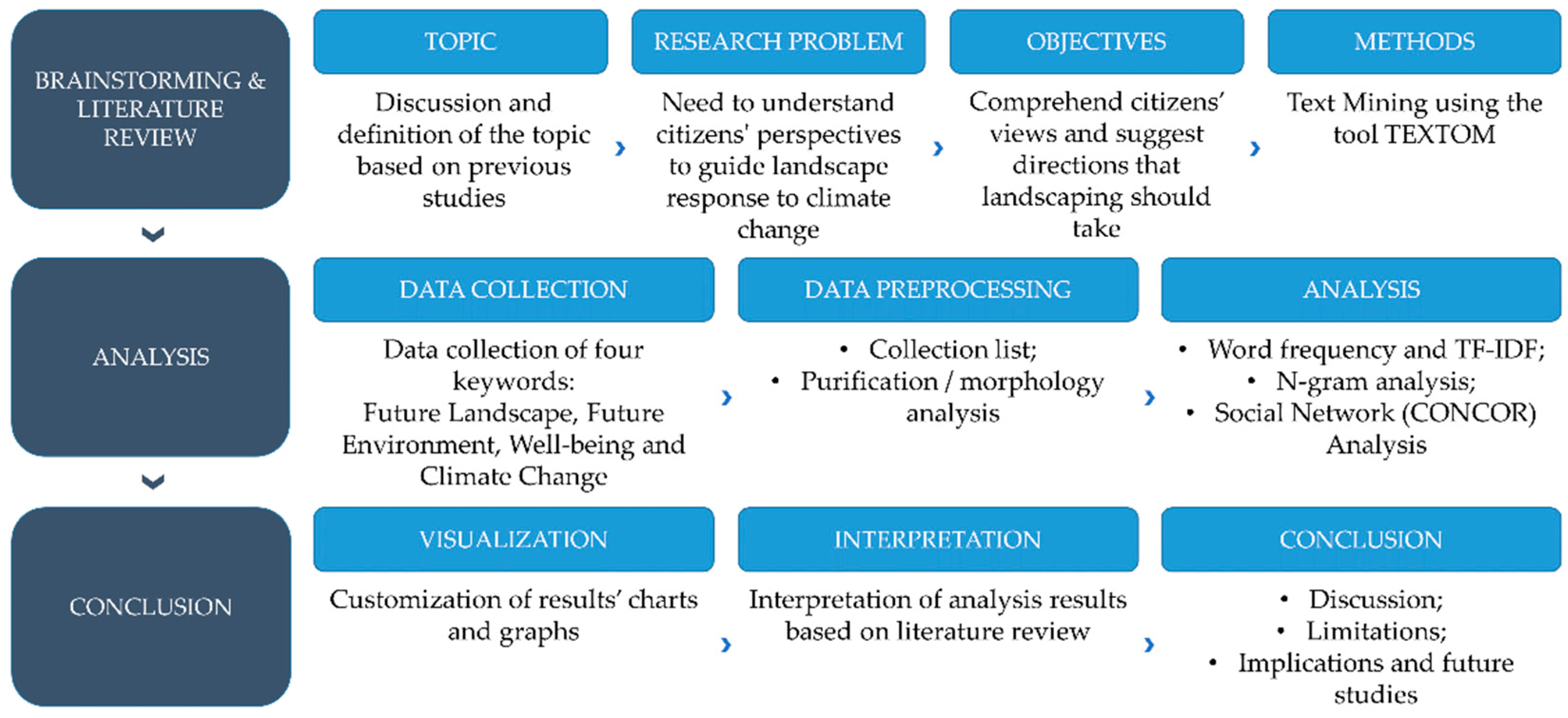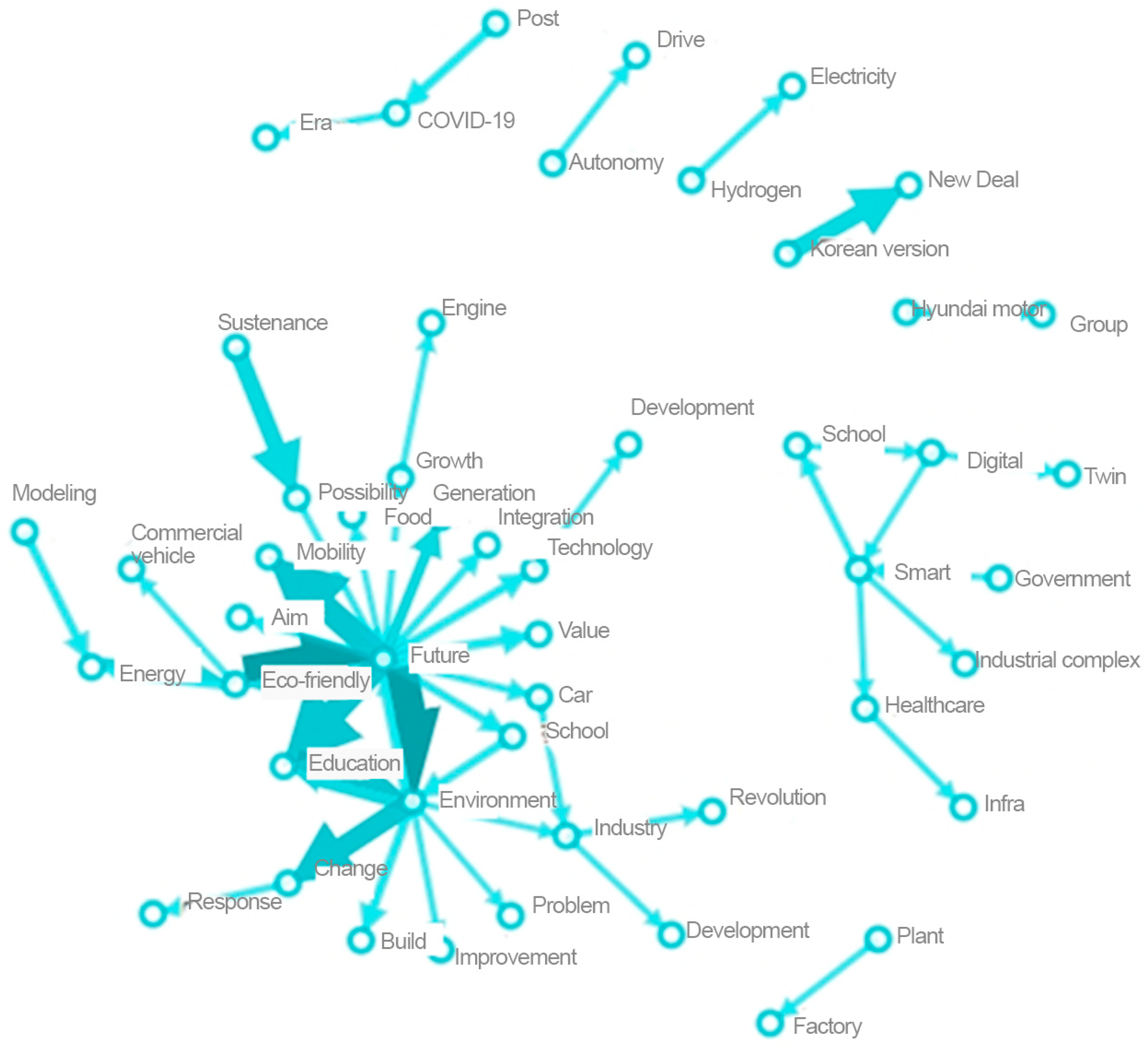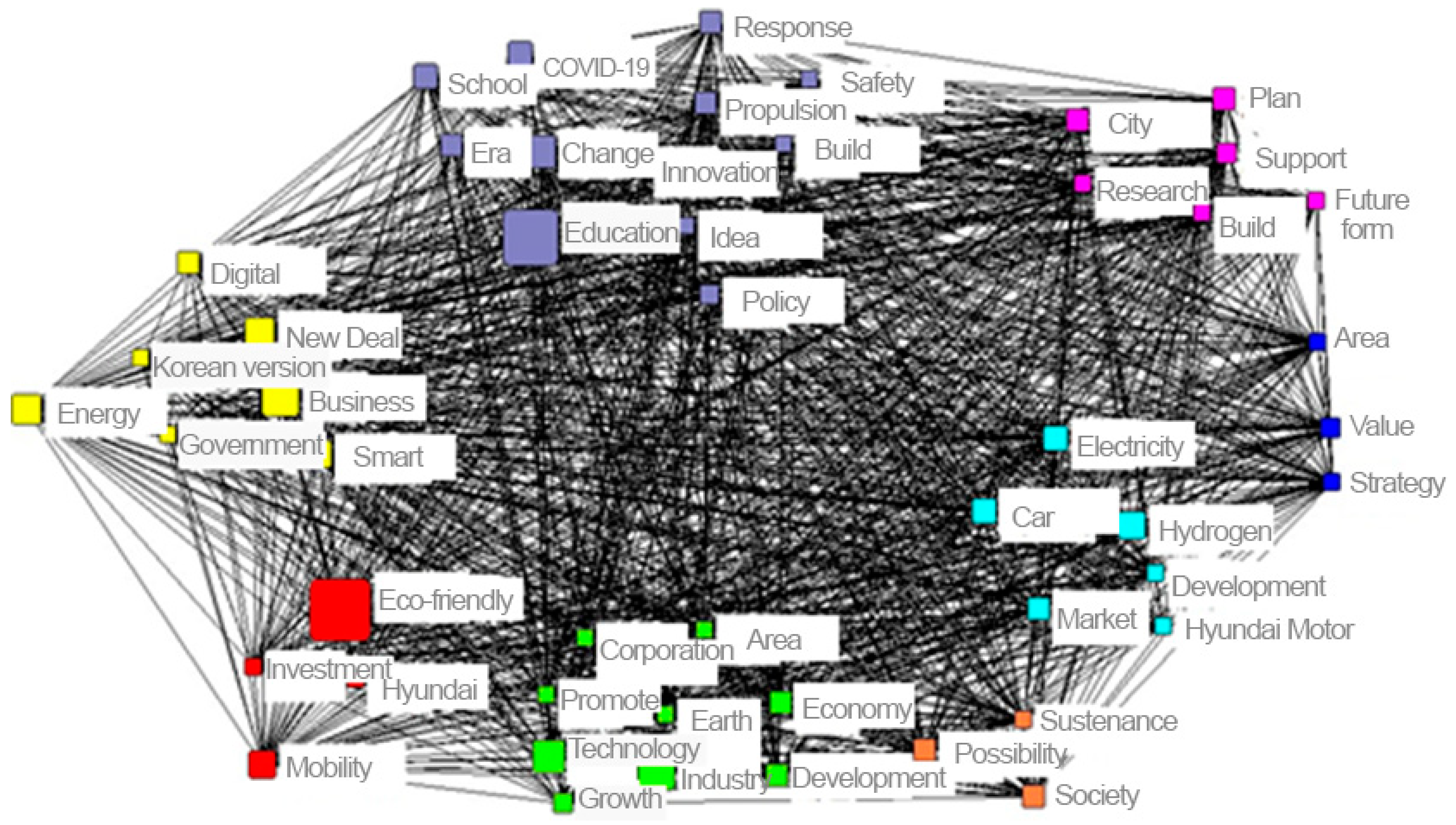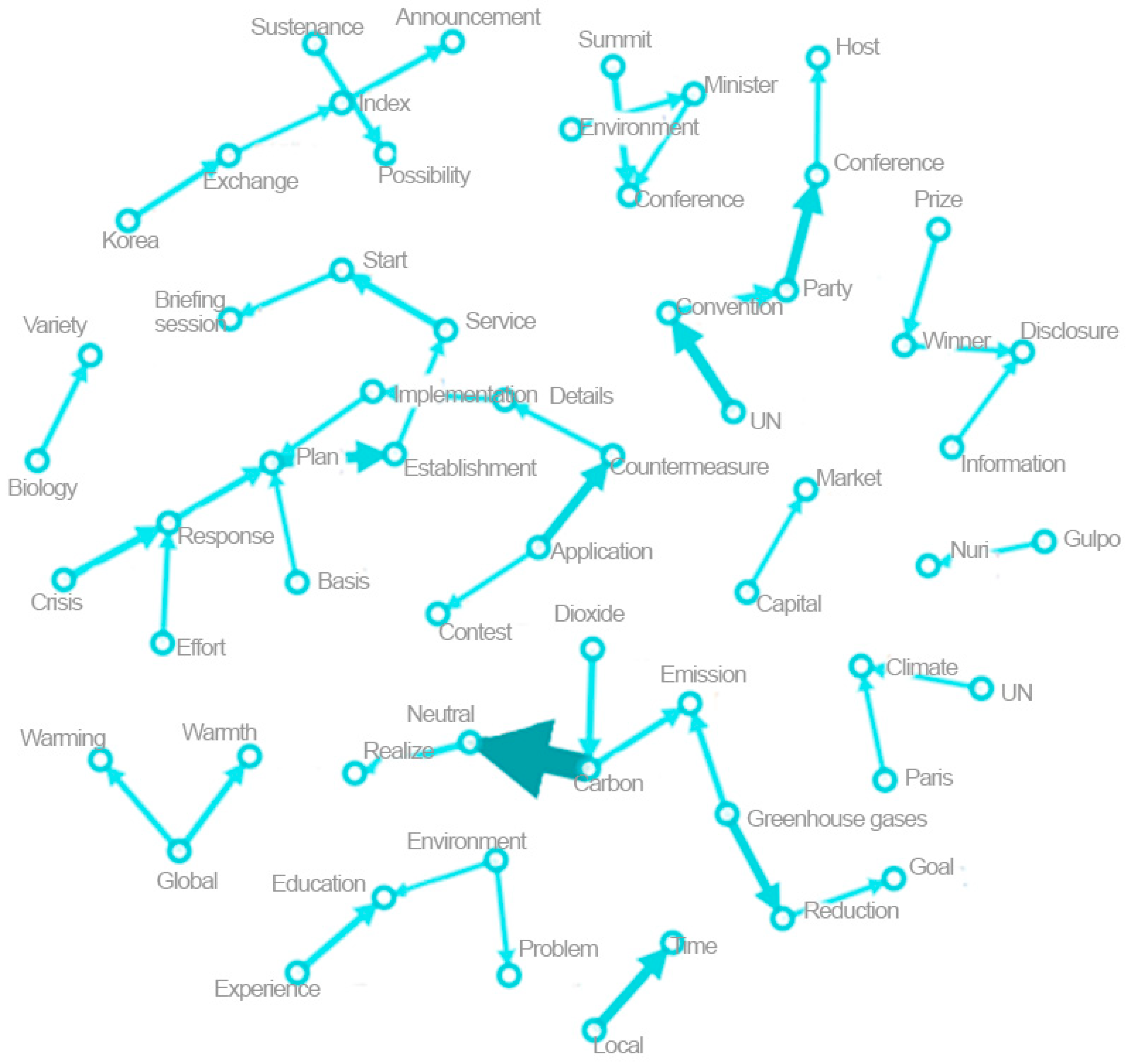1. Introduction
Emerging environmental problems due to global climate change are threatening the health and survival of humankind along with changes in the future environment. From climate-related illnesses to risks to food safety and nutrition, mental health and well-being, the occurrence of these threats has increased alarmingly [
1]. The interactions among rapid urbanization, the concentration of population in urban areas changing the urban form, and climate change can create various risks for cities, such as urban heat islands, flooding, water scarcity, and other hazards [
2]. The reduction of biodiversity is becoming more serious, as climate change is affecting ecological processes and endemic and threatened species are under environmental pressure [
3,
4]. Asian cities have regionally specific risk profiles, as the rapid land-use change, and global processes increase the risk of extreme events [
2,
4].
South Korea is a country deeply impacted by climate change, with one of the highest increases in the average temperature compared with other countries, resulting in increasing concern among citizens, who believe that the government should take responsibility to address this issue [
5]. Since the COVID-19 outbreak, the restrictions on activities affected human well-being, as participation in recreational activities declined [
6]. However, according to the “COVID-19 Community Mobility Report” released by Google, the use of parks in South Korea has continuously increased since the spread of the pandemic, with the infectious disease being one of the main factors impacting the growth [
7,
8]. Therefore, the demand for a healthier and safer outdoor space has increased significantly, and as leisure activities in indoor spaces were restricted, parks became a solution with a relatively low risk of infection from COVID-19, where physical activities and social exchanges are possible within a limited range [
9]. Moreover, climate change can increase the use rate of urban greenspaces as citizens seek a cooler microclimate in green areas during periods of high temperatures [
10].
This urgently requires practical studies in landscape science in terms of responding to climate change, dealing with rapid urbanization, and improving urban ecosystem services. Modern landscaping is a specialized field that practices all three directions, and its social value is being reset [
11]. Landscape architecture is attracting attention in this respect, with its role recently expanded, as research related to “landscape urbanism” is being actively conducted [
12]. As the awareness of the loss of biodiversity and the importance of ecosystems is increasing, the recognition of the potential of ecological systems to respond to climate change is also increasing. Therefore, using landscape systems as a response to climate change is an emerging topic among scholars [
3]. The Ministry of Economy and Finance released the Korean Green New Deal Policy in 2020, with a list of projects aiming for a green transition of infrastructures, comprising plans to turn “public facilities into zero-energy buildings, restore the terrestrial, marine, and urban ecosystems, and build a management system for clean and safe water” [
13]. To achieve these goals, landscaping can be used as a strategy to build green infrastructure, parks, and green areas to promote health and well-being after the COVID-19 pandemic. In addition, it is possible to pursue the convergence of all fields of landscape-related industries, such as virtual reality and the smart city concept. Taking into consideration that “collecting, disclosing and utilizing data in areas closely related to people’s lives” is one of the projects of the Digital New Deal [
13], this approach can contribute to gathering data to plan countermeasures according to future environmental changes by communicating with the “digital generation” in the digital space.
Considering regionally specific risk profiles, it is possible to affirm that landscape and climate change have implications for adaptation at the ground level. Still, subjective sense of place and landscape are still poorly researched in studies of adaptation to climate change, although individual perceptions can lead to different climate adaptation approaches [
14]. For this reason, this research was conducted to understand the perception and prospects of residents on the local level, and to give insights into how landscaping could properly respond to urban changes considering citizens’ perspectives.
Most of the research related to South Korean citizens’ perception of the urban environment and landscape is focused on post-occupation analysis, usage behavior, or preference analysis using surveys and questionnaires [
15,
16,
17,
18] and even mapping [
19] methods to propose improvement plans for green areas. However, some studies, especially after the COVID-19 outbreak, were conducted using text mining and social network analysis [
20,
21,
22,
23] to analyze behavior characteristics, use changes, and users’ perceptions, as personal contact became difficult. Comparing the results of the previous studies, it was possible to see that the studies conducted using text mining allowed the analysis of a much larger amount of data (such as 268.319 SNS posts [
20]) and the analysis of data collected from a longer period of time (from June 2017 to May 2020 [
21]) than compared to the studies that used questionnaires and field surveys (497 samples collected for 21 days [
18]). Jin et al. [
24] used several text mining methods such as keyword network analysis, among others, and identified an increasing frequency of specific phenomena terms resulting from climate change in environmental news channels, such as heat waves and cold waves, as well as a trend of policy discussion on climate change issues.
Text mining extracts meaningful structured information from text data, enabling the identification of key concepts and their relationships, patterns, and attributes [
25]. As the cost and time of collecting large-scale data are reduced with text mining methods, research analyzing key issues or trends using big data is increasing. However, more research in the environmental field is needed, as it is still in the early stage [
24]. Therefore, it is expected that this methodology combined with visual representation can demonstrate common future landscaping trends.
In this context, this study aims to analyze the keywords “future landscape”, “future environment”, “well-being”, and “climate change” from citizens’ perspectives, using text mining and social network analysis. In
Section 2, we introduce the TEXTOM tool, and the text mining techniques used: word frequency, TF-IDF, N-gram, and CONCOR analysis. In
Section 3 we present the text mining results, following the sequence mentioned above for each keyword. Furthermore, in the discussion section, we attempted to suggest directions that landscaping should take to respond to changes in the future environment based on the local context, as citizens are the main users that experience and give sense to the landscapes. Finally, in the conclusion section, we present the main findings, limitations, and implications of the study.
2. Materials and Methods
Big data analysis allows the collection of raw data for the desired keyword in a short time and at low cost, also providing the possibility to grasp the changing aspects of society quickly. By identifying patterns and prospects through text mining, visualization of the results makes it easy to persuade citizens about policies and logically present solutions. Therefore, to analyze citizens’ perceptions of landscape in the scenario of COVID-19 and the digital era, the text mining approach was selected to investigate a large amount of data that will provide insights into important factors that impact the practice of landscaping and planning of green policies. The research structure is presented in the following diagram (
Figure 1).
This study uses the TEXTOM tool to collect data from Korean blogs and social networking service posts. Data collection for this study was conducted by limiting the period to about one year, from July 2020 to July 2021, about the four keywords (originally in Korean) “future landscape”, “future environment”, “well-being”, and “climate change” from representative search engines in South Korea such as Naver, Daum, and Google. The collection channels were chosen due to the following reasons: first, because they are the top three most used channels in South Korea, and second, as the purpose of this study is to find out the overall trend of landscape and environment, news websites and blogs are relatively rich sources of content where users freely share their experiences and opinions.
The four keywords were chosen based on previous studies and mainly based on the Sixth Assessment Report of the Intergovernmental Panel on Climate Change [
4]. In the chapter that describes impacts, adaptation, and vulnerability with a focus on Asia, it is mentioned that Asian countries are the most vulnerable to climate risks, with cities and infrastructure, and terrestrial ecosystems being the main sectors susceptible to multiple hazards. The chapter also emphasizes the effects of climate change on the health and well-being of citizens, as vulnerability to extreme weather events increases water-related illnesses, malnutrition, mental health problems, and allergies. Regarding the measures that have been adopted to adapt to climate change, the report shows that solutions based on ecosystems, such as the planning of urban parks and green spaces aiming to reduce risks such as extreme heat and heat islands, have a medium impact on reducing risks and high impact on human well-being [
4]. Therefore, it was identified that the four keywords have an important connection and relevance to this study, since “climate change” directly impacts the “future environment” and the “well-being” of citizens, and the practice of landscaping provides proven effective solutions to mitigate risks and improve the human well-being through the creation of parks and green spaces.
2.1. Data Collection and Preprocessing
TEXTOM, a Korean-based big data program, is a software that is useful for network analysis as it searches for keywords on search engines to provide data and related terms rankings and provides matrix information according to the frequency of the searched keywords [
26]. In the first step, the keywords, collection period, and collection channels were defined and inserted in the TEXTOM tool to collect the data. After obtaining the unstructured data, in the preprocessing stage, a refining process was performed to subdivide the collected unstructured data into morphemes [
27]. Unnecessary words such as pronouns and synonyms, and duplicated posts were deleted, and to secure the reliability and objectivity of the research results, the final data to be used in the research were obtained after the third refining process. The text mining techniques applied are explained below.
2.2. Text Mining Analysis
Text mining, or text data mining, is a method of extracting meaningful data by modeling and structuring unstructured text data using a mechanical algorithm [
28]. In addition, text mining is an exploratory data analysis process that allows for the discovery of useful, previously unknown information [
29,
30,
31]. In other words, it is a process of structuring an input text from a large amount of data, inducing connections and patterns through various mechanical algorithms in the structured data, and grasping their meaning to generate novel insights.
2.2.1. Word Frequency and TF-IDF Analysis
Word frequency and term frequency–inverse document frequency (TF-IDF), which indicate keywords’ frequency occurrence, are statistical numerical data indicating how important a specific word is [
32]. TF-IDF mainly uses a method in which the importance of words is determined by calculating the weights between documents containing specific words, and sorting the weights with high values for the purpose of extracting keywords [
33]. Frequency of appearance was analyzed through the four keywords “future landscape”, “future environment”, “well-being”, and “climate change”, and TF-IDF analysis was conducted to derive related terms for each keyword.
2.2.2. N-Gram Analysis
N-gram analysis is a method that calculates and visualizes a sequence of N words, which can represent the frequency of syllables or words placed after a particular word in a large volume of documents as quantitative figures [
34]. By examining the connection between the derived terms and initial keywords, the meaning of the derived keywords was identified, and the connection strength and related words that are important within each keyword were obtained.
2.2.3. Social Network (CONCOR) Analysis
CONCOR analysis is a method of classifying groups with an appropriate level of similarity by repeatedly performing correlation analysis [
35]. In the case of semantic network analysis based on real language, the convergence of iterated correlation (CONCOR) analysis method—which divides the clusters based on the correlation of indirect connection patterns—is recommended, because words are an organization without a hierarchy [
36]. Detailed research areas were classified through CONCOR analysis by grouping words with high relevance. When visualized by CONCOR analysis, the higher the frequency of words, the larger the node size, and the thicker the connection line between the nodes, the stronger the connection strength between words. It analyzed how words were related by keyword and identified the meaning and relationship between words based on urban residents’ opinions.
Analysis results were organized into tables and graphs for visualization, and interpretation was conducted based on the literature review as presented in the next section.
4. Discussion
This study examined the perceptions of South Korean citizens in regard to landscape and environmental changes through text mining and social network analysis methods. The analysis of related terms, meanings, and connection strengths derived from the four keywords “future landscape”, “future environment”, “well-being”, and “climate change”, helped to elucidate directions and implications for landscaping at the local scale. Based on this study’s results, the relevance of words related to the perception of urban residents for each of the four keywords is as follows.
1. The results showed that “future landscape” is strongly associated with real estate value, which can be explained by the fact that more than half of the South Korean population currently live in apartment complexes [
38], where landscaping becomes a component that increases marketing value. Words such as “complex”, “apartment”, “future value”, and “sale” showed high frequency and close relationship. In the N-gram analysis, the strength of the connection between “complex-landscape” and “future-value” was higher than for the other keywords. This emphasizes that landscape is recognized as a factor that influences the quality of life of residents adding real estate value to apartment complexes, thus being a relevant point to be considered in future landscaping. This influence on residents’ quality of life was also identified in the study conducted by Tae et al. [
57], which demonstrated that apartment complex landscaping spaces (ACLS) have a positive impact on improving residents’ life satisfaction and psychological well-being, suggesting that these spaces should be attractively planned and balanced in design, promoting a feeling of being “out of the ordinary”. This directs to the need to study diverse approaches, such as adding walking trails or vegetable gardens, so that residents and other users can enjoy landscaping spaces in a dynamic and active way.
2. For “future environment”, “eco-friendly” had the highest frequency followed by “education”, while in the TF-IDF analysis “education” had the highest frequency followed by “eco-friendly”. This result can be interpreted as an increasing interest in environmental issues, while the frequency of the terms “New Deal”, “hydrogen”, and “mobility” indicates growing attention to government measures to cope with climate change. In most cases, the words are connected with the keyword “future”, also indicating concern and uncertainty regarding the future environment. This suggests that means to expand the population’s knowledge of eco-friendly measures and encourage active participation should be provided, as well as that approaches in line with the Green New Deal should be developed, such as the inclusion of green infrastructure in public buildings and schools.
3. For “well-being”, “Green Cross”—a well-being-related company—showed the highest frequency, while the term correlation of “satisfaction-index” showed the highest connection strength. Well-being is a topic that is becoming a social trend, especially in the face of environmental problems and the occurrence of pandemics such as COVID-19. Considering the frequency of words related to food, and also words such as “environment” and “park”, “health”, “consumer”, “satisfaction”, and “index”, it is possible to identify that the population associates well-being mainly with healthy food and environments, which justifies the relevance of companies focused on health supplements, and also highlights the importance of creating open green spaces for leisure and physical activities, as it is reported to provide positive outcomes to physical and psychological well-being [
58]. With the increase in the use rate of parks after the pandemic, it is possible to affirm the need to improve the function of these spaces with a focus on healing and well-being experiences.
4. For “climate change”, the keyword “response” showed the highest frequency, followed by “carbon” and “environment”. This shows that residents associate carbon emissions as one of the causes of climate change, while also elucidating the perception of the effects of climate change on the environment. As shown in the N-gram analysis, the connection of the terms “carbon-neutral”, “UN-convention”, “plan-establishment” and “party-general assembly”, demonstrates the interest of citizens in policies that discuss measures to mitigate the effects of climate change. Therefore, as South Korea has already been suffering the negative impacts of climate change, such as extreme events, flooding and reduction of biodiversity [
59], and residents expect effective government measures, it is important to think about the landscaping role as a means of accomplishing the goals defined in green policies to cope with climate change.
The strategy of analyzing the perception of South Koreans through text mining made it possible to access a large amount of information that contributed to a general understanding of trends in the environment and landscape. The TEXTOM tool demonstrated great effectiveness in the process, as it helps non-experts from the very first step of obtaining unstructured data and pre-processing, to creating the final graphics for visualization. The results, however, were interpreted based on the background of landscaping professionals and students, with a focus on climate change and well-being. In addition to the use of other keywords that can lead to different results, there are also other text mining techniques, such as sentiment analysis, that could provide more in-depth information on the subject, and that can be considered for complementary studies.
Through green infrastructure, parks, gardens, and freshwater management, the interdisciplinary practice of landscaping can expand ecosystem services that are cultural (recreation, aesthetic value, etc.), regulating (climate, air quality, water purification, etc.), supporting (nutrient cycling, etc.), and provisioning (food, fresh water etc.) [
60]. In this way, the practice of landscaping has great potential for responding to environmental changes, and landscape professionals should consider that, according to the results obtained in this study, South Korean citizens are aware, at least partially, of this potential and therefore expect eco-friendly measures aligned with policies to respond to climate change, and that landscaping spaces in apartment complexes are gaining greater relevance and value.

















